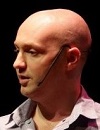Times are all Pacific Standard Time (UTC - 8:00)
After over two years of being kept apart, it's time to bring people together. When one thinks of the metaverse, what are interactions going to look like, will we be able to see high-resolution expressions, can we hear everybody’s voices. Small nuances are really important in those human interactions. In this session we will hear what things are happening in the development of XR hardware that will enable the metaverse, while also looking at cultural and ethical implications, wearabililty, manufacturing and more. In 2021, the eyewear market is already a $115 billion industry. It will be interesting to see how metaverse will change it.8:00 AM
Opening
 |
|
8:20 AM
Keynote
 |
|
Mesh: A More Equitbale World
Grace Hwang leads a cross-disciplinary team at Microsoft that explores what the future of 5-year-old HoloLens mixed-reality project looks like—a glowing, secondary world of holographic objects and people that can appear in an ordinary home or office. This year, the company debuted its Mesh platform—a virtual conference room where people can meet not just via HoloLens but also through an Android tablet, iPhone, or Oculus VR headset. Current customers include Accenture and Ray and Mark Dalio’s non-profit, OceanX.
9:00 AM
Creating Attractive Prescription Smart Eyewear...
 |
|
...without looking like a character from Star Trek.
Today it is possible to 3D print lenses in volume, enabling unique benefits for traditional prescription lenses and for smart eyewear. With 3D printing lenses can be printed with spheres, aspheres, cylinders, prisms, bifocals, trifocals, progressives and anything in-between. It is possible to integrate devices inside these prescription lenses for example, waveguides, films, sensors, lcd or anything else you can think off. It is possible to create airgaps or to print directly on the device. The device can be glass or plastic. The latest innovation is that we can print not only on flat but also on curved surfaces.
9:20 AM
Autofocal Eyewear is the Future
 |
|
Autofocal eyewear: innovative vision correction as a platform for novel smart glass functionalities
Morrow’s Autofocal eyewear tackles the intrinsic trade off multifocal/progressive eyewear users are faced with, being higher reading power and reduced field of view. In the first part of this talk, we’ll introduce the integration challenges that were overcome to make conventional prescription glasses ’smart’, and explain how our product is kept simple but meticulously geared towards the needs of our customers. In the second part, we’ll reflect on the potential roadmap towards more functionalities, and how a collaborative crossover with AR/VR parties might look like.
9:40 AM
The Role of Simulation in Developing the Next Generation of Mixed Reality Systems
 |
|
The Role of Simulation in Developing the Next Generation of Mixed Reality Systems
The past several years have seen significant progress in the design of robust, scalable mixed reality systems. During that time, considerable investments have been made in the development of diffractive technologies for mixed reality. Nonetheless, catadioptric solutions are still a viable, if not preferred, alternative for many applications. Simulation is critical to determining the best technology for the desired application, and advanced technologies – such as Rigorous Coupled Wave Analysis – are required to simulate both solutions (diffractive vs. catadioptric). In this talk, I will highlight the use of these advanced technologies in the design and development of next-generation mixed reality systems.
10:00 AM
Curved Waveguide Encapsulated in Spectacle Lenses
 |
|
The first high-resolution curved waveguide with replicated eye-boxes, encapsulated in spectacle lenses. The move towards a more digital and contactless world will increase the demand for holographic optics as the core optic in a pair of glasses or car windshields. How will we do that? Find out.
10:20 AM
High Resolution in VR Displays
 |
|
Dynamic aberrations correction enables users to see high resolution in VR displays.
The presentation shows how dynamic aberrations correction can increase the apparent resolution, eliminate color fringing and pupil swim effects, and enlarge the eye-box in the highest-end displays, such as Varjo VR-1 and HP Reverb G2.Having to achieve high resolution, wide field of view, and large eye-box, the VR/AR head-mounted display makers face the challenges impossible to overcome by hardware design alone. Even the latest-and-greatest devices retain the common flaws spoiling user experience: blur and color fringing outside of the small “sweet spot,” picture quality degradation and geometry distortion at wide gaze angles, and a tiny eye box. In order to achieve realistic picture quality and natural visual experience, the rendering pipeline has to include advanced image pre-processing beyond the standard geometry warp and channel scaling. Almalence created the Digital Lens, a computational solution utilizing a precise characterization of HMD optical properties along with a dynamic aberration correction technique, adjusting on the fly to the eye-tracking data.
10:40 AM
Is Enterprise AR is Outperforming Consumer AR
 |
|
Is Enterprise AR is Outperforming Consumer AR
AR headsets are being used to improve efficiency in staff training, manufacturing, production and design, etc. As it evolves, AR will provide immersive step by step instructions for technicians, leading to time saving and cost reduction. AR makes work more accurate and work environment safer through engaging simulation and training of different scenarios. On the consumer side, it’s mostly mobile AR that prevails in mass market. The major factor which are fueling the AR market growth of consumers is worldwide high penetration of smartphone and mobile devices. Which going to win?
The session is followed by a panel 11:00 - 11:45 AM
Next Steps for Prescription Smartglasses panel and Q&A.